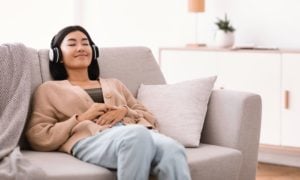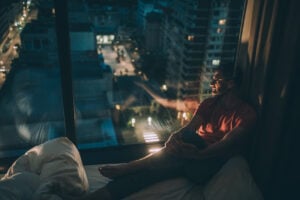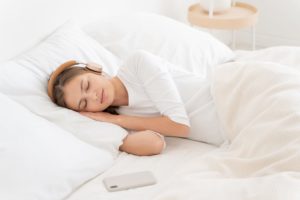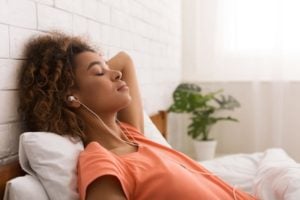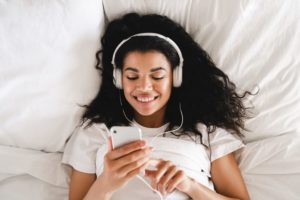White Noise
- White noise is a specific type of broadband sound that includes all the audible frequencies.
- Brown noise and pink noise are broadband sounds like white noise, but are perceived as deeper sounds.
- Researchers do not yet know how white noise improves sleep for some people, but one theory is that it masks background noises that can disrupt sleep.
Unexpected noises can easily disturb sleep. Some people find that the neutral sound of white noise can minimize these disturbances and help them sleep better, but this may not be the case for everyone.
We take a closer look at what makes white noise different from other types of noise, how to use a white noise machine, and how it may help you sleep.
Is Your Troubled Sleep a Health Risk?
A variety of issues can cause problems sleeping. Answer three questions to understand if it’s a concern you should worry about.
What Is White Noise?
White noise refers to a noise that contains all frequencies across the spectrum of audible sound in equal measure. Because white noise spans multiple bands of sound, it is sometimes referred to as broadband noise. Anecdotally, people often liken white noise to the static that comes from an untuned radio or television.
Researchers have studied the effect of white noise on humans for many years, finding evidence it can reduce crying in infants, improve work performance, and potentially help counteract symptoms of attention-deficit/hyperactivity disorder (ADHD) . Multiple studies have also examined how white noise may affect human sleep.
White Noise vs. Other Colors of Noise
Although white noise is the most commonly known, there are several other colors of noise.
- Pink Noise: Like white noise, pink noise is a broadband sound containing components from across the sound spectrum. Pink noise contains sounds within each octave, but the power of its frequencies decreases by three decibels with each higher octave. As a result, pink noise sounds lower pitched than white noise. Researchers have compared the sound of pink noise to the noise produced by a waterfall . Studies have found that pink noise can enhance deep sleep in older adults and improve cognitive performance.
- Brown Noise: Brown noise, also called red noise, contains sounds from every octave of the sound spectrum, but the power behind frequencies decreases with each octave. This decrease is twice as great as that in pink noise, resulting in a sound people perceive as deeper than either white or pink noise. In research trials, people have said brown noise reminds them of the sound of rainfall or a shower . Studies have shown brown noise might be useful in reducing symptoms experienced by people who have ringing in their ears and at improving cognitive performance, but its effect on sleep has not been widely studied.
- Green Noise: While white noise contains equal volumes of all the sound frequencies, green noise amplifies the frequencies in the middle of that range. Green noise sounds are perceived as similar to ocean waves or a stream. Although there is limited research that shows green noise benefitting sleep, it is a popular tool to help mask noisy environments that disrupt sleep.
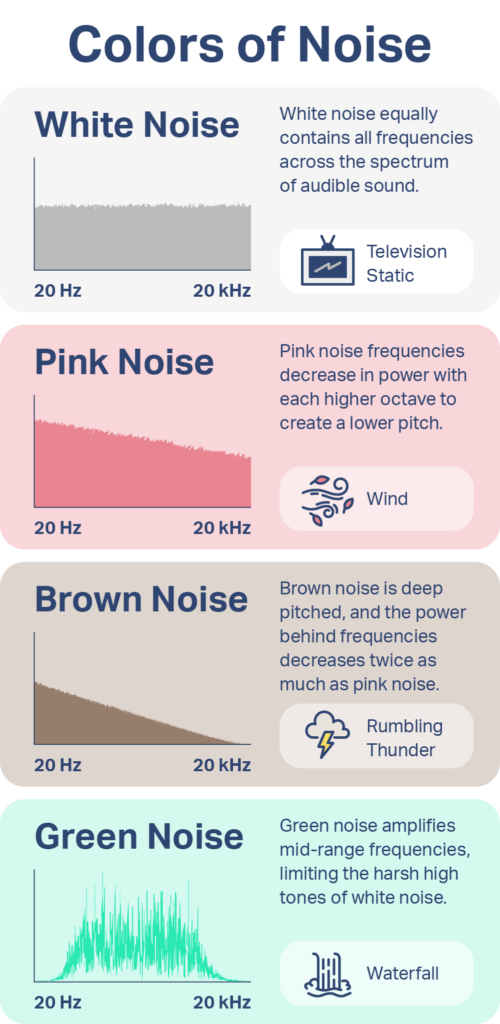
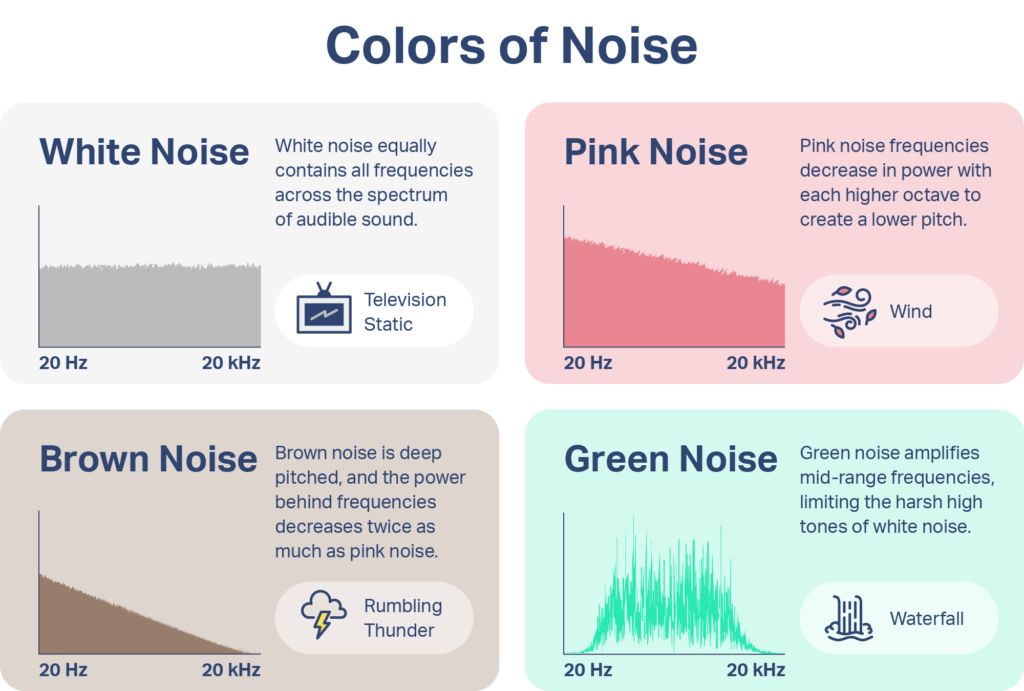
Does White Noise Help You Sleep?
More research is needed to confirm whether white noise improves sleep — perhaps by synchronizing brain waves — or if the sound primarily helps by masking background noise.
A recent analysis of multiple studies looking at white noise’s effect on sleep has produced mixed results . The authors call into question the quality of existing evidence and conclude that further research is necessary in order to widely recommend white noise as a sleep aid. They also note that in some instances, white noise can disturb a person’s sleep and may affect their hearing.
Studies have found that listening to white noise helped newborn babies fall asleep faster and affected the amount of time adults spent in different sleep stages when played throughout the night.
Another study found that adults fell asleep 38% faster while listening to white noise. Other recent studies have continued to find white noise positively affecting sleep. For example, people living in a high-noise area of New York City fell asleep faster and spent more of their time in bed asleep while listening to white noise . In another study, listening to white noise through headphones improved sleep quality for critically ill patients in a loud hospital unit.
Disruptive noise during sleep can cause changes in heart rate that suggest the sleeper is experiencing semi-awakenings. Transportation sounds like cars and planes are considered a major contributor to poor sleep, with possible health ramifications. Researchers are hopeful that the steady hum of white noise might reduce a sleeper’s sensitivity to unpredictable noises from the environment.

How To Choose a White Noise Machine
There are many factors to consider when choosing a white noise machine.
- Machine or app: A white noise machine tends to be larger and more expensive, but it might come with better sound quality. A smartphone app could be more convenient while traveling, since it does not require you to bring any additional devices with you.
- Cost: Some white noise apps offer a free or very low-cost version. White noise machine prices vary greatly, though many options cost between $50 and $100.
- Sound quality: White noise machines either play a digital white noise recording or mechanically create a white noise sound. Check reviews of the white noise products you are considering to see what other customers have said about the sound quality.
- Volume control: Being able to control the volume of your white noise machine is essential. Check the manufacturer’s specifications for the lowest and highest available volumes to ensure the white noise machine meets your needs.
- Sleep timer: Most white noise machines have some type of sleep timer, but their functionality varies. Some allow the user to program in any amount of time, while others have preset blocks of time you can choose from.
- Other sounds: If you have never used white noise to help you sleep before, consider opting for a white noise machine or app that also has other sleep sounds, in case you find you do not enjoy falling asleep to white noise.
Setting Your White Noise Machine Volume
There are no official guidelines for setting the volume of a white noise machine for sleep. That said, exposure to noise measuring 70 decibels or more – like that of city traffic – can become hazardous over time. Ringing in the ears and hearing loss are both risks of regular exposure to loud sounds.One study found that nearly 65% of infant white noise machines and apps were capable of playing sounds louder than recommended when people slept very close to the device. When determining which volume setting to use for your white noise machine, consider first moving the white noise machine to a corner of the room and keeping the noise level similar to that of a background conversation or light rustling.
Tips for Incorporating White Noise Into Your Bedtime Routine
If you are interested in a white noise machine as a way to fall asleep faster, consider making it just one part of a healthy bedtime routine.
Try to begin getting ready for bed at the same time each night so you can maintain a consistent bedtime, even on weekends. Your bedtime routine may include engaging in personal hygiene practices like brushing and flossing your teeth, washing your face, or taking a warm bath.
Once you are ready for bed, turn on your white noise machine just before turning off the lights. Consider whether you prefer the white noise to play all night long or only as you fall asleep, and set a timer as needed. Avoid screen-based devices during your nightly routine, and reserve your bed for nothing other than sleep or sex.

Still have questions? Ask our community!
Join our Sleep Care Community — a trusted hub of sleep health professionals, product specialists, and people just like you. Whether you need expert sleep advice for your insomnia or you’re searching for the perfect mattress, we’ve got you covered. Get personalized guidance from the experts who know sleep best.
References
11 Sources
-
Messineo, L., Taranto-Montemurro, L., Sands, S. A., Oliveira Marques, M. D., Azabarzin, A., & Wellman, D. A. (2017). Broadband Sound Administration Improves Sleep Onset Latency in Healthy Subjects in a Model of Transient Insomnia. Frontiers in Neurology, 8, 1.
https://pubmed.ncbi.nlm.nih.gov/30670235/ -
Thomson, H. (2018). How flashing lights and pink noise might banish Alzheimer’s, improve memory and more. Nature, 555(7694), 20–22.
https://pubmed.ncbi.nlm.nih.gov/29493598/ -
Barozzi, S., Ambrosetti, U., Callaway, S. L., Behrens, T., Passoni, S., & Del Bo, L. (2017). Effects of tinnitus retraining therapy with different colors of sound. The International Tinnitus Journal, 21(2), 139–143.
https://pubmed.ncbi.nlm.nih.gov/29336133/ -
Riedy, S. M., Smith, M. G., Rocha, S., & Basner, M. (2021). Noise as a sleep aid: A systematic review. Sleep Medicine Reviews, 55, 101385.
https://pubmed.ncbi.nlm.nih.gov/33007706/ -
Spencer, J. A., Moran, D. J., Lee, A., & Talbert, D. (1990). White noise and sleep induction. Archives of Disease in Childhood, 65(1), 135–137.
https://pubmed.ncbi.nlm.nih.gov/2405784/ -
Scott, T. D. (1972). The effects of continuous, high intensity, white noise on the human sleep cycle. Psychophysiology, 9(2), 227–232.
https://pubmed.ncbi.nlm.nih.gov/4336955/ -
Messineo, L., Taranto-Montemurro, L., Sands, S. A., Marques, M. D., Azabarzin, A., & Wellman, D. A. (2017). Broadband sound administration improves sleep onset latency in healthy subjects in a model of transient insomnia. Frontiers in Neurology, 8, 718.
https://pubmed.ncbi.nlm.nih.gov/29312136/ -
Ebben, M. R., Yan, P., & Krieger, A. C. (2021). The effects of white noise on sleep and duration in individuals living in a high noise environment in New York City. Sleep Medicine, 83, 256–259.
https://pubmed.ncbi.nlm.nih.gov/34049045/ -
Warjri, E., Dsilva, F., Sanal, T. S., & Kumar, A. (2021). Impact of a white noise app on sleep quality among critically ill patients. Nursing in Critical Care, 27(6), 815–823.
https://pubmed.ncbi.nlm.nih.gov/34931413/ -
National Center for Environmental Health. (2022, November 8). What noises cause hearing loss? Centers for Disease Control and Prevention., Retrieved February 17, 2023, from
https://www.cdc.gov/nceh/hearing_loss/what_noises_cause_hearing_loss.html -
Hong, S. A., Kuziez, D., Das, N., Harris, D., & Brunworth, J. D. (2021). Hazardous sound outputs of white noise devices intended for infants. International Journal of Pediatric Otorhinolaryngology, 146, Article 110757.
https://pubmed.ncbi.nlm.nih.gov/33992973/


